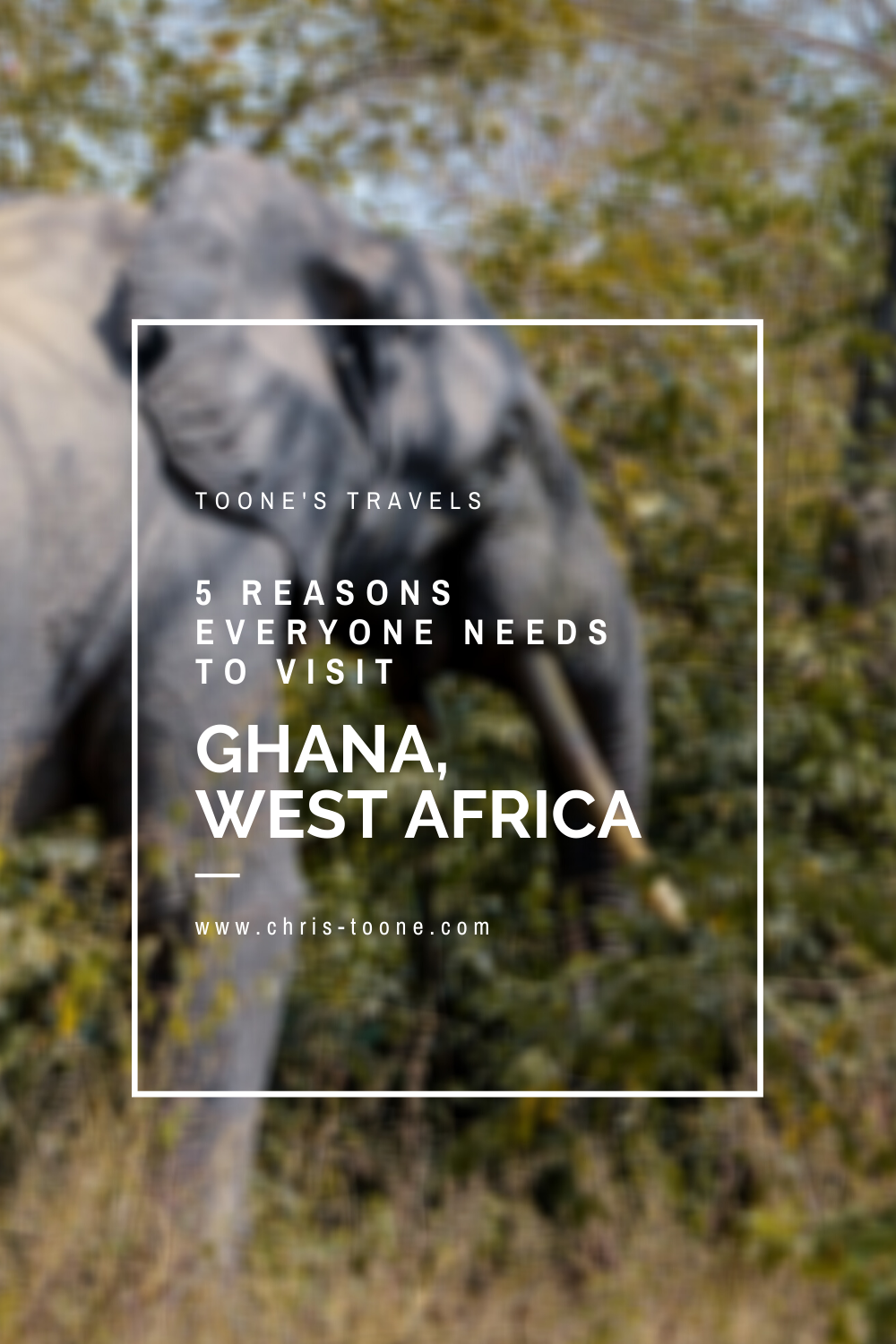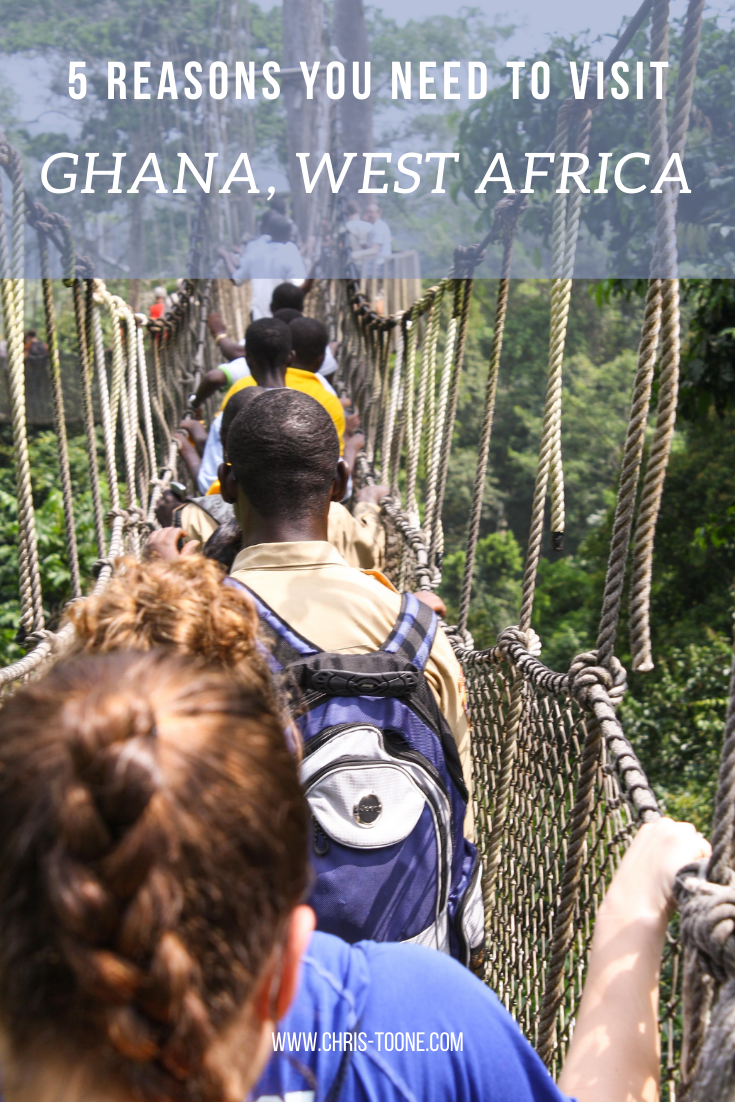5 reasons why you should visit Ghana at least once in your lifetime
Please note: This post was updated as of December 2023
Although widely considered to be "Africa for beginners," Ghana is often overlooked by travelers.
I suppose, in a way, it can be quite overwhelming with too much nature to explore, too many foods to choose from, or a local culture too vibrant to step into.
Sounds terrible, right?
Here are 5 reasons that you should make time to visit Ghana at least once in your lifetime!
1. DIVERSE WILDLIFE
A one hour flight north of Accra to Tamale gives access to Mole National Park, the epicenter of Ghana’s wildlife.
Mole was the first National Park established throughout the country and covers 4,577 square kilometers of burnt orange savannah.
Once inside the park, visitors are transported into a world full of wildlife, including antelopes, bushbucks, monkeys, rare birds (most notably the white-backed vulture), and even leopards, although extremely rare.
It’s not uncommon to be wandering the grounds of the Mole Motel, only to stumble upon a family of warthogs grazing in the grass.
Don’t get distracted for too long though, as the pesky baboons aren’t shy about rummaging through your belongings. During my first visit, I zoned out at breakfast only to realize a baboon had jumped onto the table, stolen the toast and butter, and was cheekily consuming it 10 yards away.
What’s so special about Mole National Park, you ask? The elephants.
Yes, I failed to mention that it’s an elephant hot spot and a prime place for viewing these magnificent mammals between December and April.
Due to the lack of predators within the park’s boundaries, safaris can be done on foot when accompanied by an armed guard. This means that visitors can come within mere feet as elephants graze the savannah.
In total, Mole National Park encompasses 90 different species of mammals, 334 of birds, 33 of reptiles, and approximately 120 of butterflies.
It was a surreal experience, to say the least.
Other places of note include the Boabeng Fiema Monkey Sanctuary in Nkoranza and the remote Wechiau Hippo Sanctuary, tucked away in the Upper West Region along the border with Burkina Faso
Looking for a little more luxury? Check out Mole National Park’s Zaina Lodge. This all-inclusive resort comes complete with an infinity pool, fine dining, and games drives.
Walking with elephants at Mole National Park
2. VIBRANT CULTURE
Thailand might be known as the “land of smiles,” but I’m willing to cast my vote for Ghana to claim the title.
Upon landing in Accra, visitors will notice the positive vibes that are emitted from the locals as they smile and greet everyone that passes by. Don’t be surprised if you make a few friends on the streets and the two of you are suddenly chatting as childhood best friends do. It’s completely normal.
Ghanaians aren’t afraid to express themselves through any means and the perfect place to experience it all at once is Makola Market. Wander through the narrow paths as sellers shout their prices, negotiations become animated, and people move to the beat of the music that fills the air.
It’s no wonder everyone is so happy. In a sea of dust and smog, Ghana’s arts shine bright.
For proof, the stalls full of kente cloth goods at the Center for National Culture.
This vibrant cloth was once sacred amongst the Akan people, reserved for Kings and Queens to wear in times of great importance. Although it’s turned mainstream for the sake of souvenirs in Accra, the royal culture is alive and well in villages throughout the city.
Side note: When visiting a village it’s customary to present the elders with a bottle of schnapps. During one of my visits with Aya, we abided by this custom and he, in turn, presented us with a live goat. I’d like to think that he’s still happily roaming the fields of central Ghana where we set him free.
Whether dancing the night away with locals on the famed Labadi Beach or wandering the halls of the Artists Alliance Gallery in Accra, even the most introverted people can’t resist the vibrant culture in Ghana (I can personally attest).
Traditional drumming & dance performance in Senase, Ghana
3. DELICIOUS FOOD SCENE
Whether in search of traditional fare or cuisine from around the world, Ghana has got you covered.
Dive into a bowl of fufu, a ball of pounded cassava served with stew, or jollof rice, a mixture of tomato paste and rice that packs a punch with a pinch of habanero pepper.
Ghanaians are passionate about their jollof. So much so that a seemingly endless online debate has been taking place for years with Nigerians as to whose jollof rice is the best. For neutrality’s sake, I’m going to keep my mouth shut (but definitely have some while in Ghana, if you catch my drift).
Another personal favorite is the mouth-watering bofrot, the African version of a donut. It’s easy to find a street vendor selling this traditional fried snack on most corners, serving as a quick, easy, and cheap breakfast.
As vast as the traditional foods might be, the global food scene shines bright in the capital city of Accra.
Visit Burger & Relish in the lively neighborhood of Osu for arguably the country’s best burger or enjoy an evening at Santoku for an innovative Japanese experience.
Whatever your food preference may be, you can find it in Ghana.
Traditional Ghanaian fufu
4. DEEP HISTORY
Ghana’s vibrant culture becomes next-level when considering the dark and gut-wrenching past.
Today, 40 castles that formerly housed slaves before loading them onto ships bound for the New World dot the coastline. Of the 11 million to cross the Atlantic, most were taken to South America or the Caribbean but it is thought that around 500,000 Ghanaians disembarked in the United States.
Cape Coast Castle is the most popular of former slave sites to explore and provides visitors the opportunity to experience first-hand the suffocating, dark dungeons that housed 1,000 males and 500 females with minimal food and no sewage available.
The most chilling part of the experience is by far walking through the infamous “Door of No Return,” where slaves once took their final steps in their homeland before a life of labor elsewhere became the reality. That’s if they were fortunate enough to survive the ocean crossing.
It was on March 6th in 1957 when the resiliency of Ghanaian’s paid off and the country became the first sub-Saharan nation to gain independence.
Needless to say, there’s a long and storied history here and it begs to be explored. What better way to do so than to do it first-hand?
Cape Coast Castle looking towards the “Door of No Return”
5. UNSPOILED NATURE
A 4.5-hour drive east of Accra lies Wli Falls, conveniently situated along the border with Togo. Cascading into a pool from 80 meters (262 feet) above, it’s West Africa’s largest waterfall and just a scratch on the surface of all that Ghana has to offer.
Hikers can climb to the top of Mount Afadjato (885 meters/ 2,903 feet) the highest peak in the country, while beachgoers can head south to Ada Foah and stay at the off-the-beaten-path Maranatha Beach Camp for some much-needed relaxation and fun in the sun.
Maranatha Beach Camp in Ada Foah, Ghana
If mountains and beaches don’t do it for you, then how about rainforest hiking?
Kakum National Park is located a short drive north of Cape Coast, Ghana and encompasses 360 square kilometers of the country’s rapidly receding vegetation.
It’s also the home to the famed canopy walk where visitors saunter between the treetops on a precariously placed piece of wood (it’s completely safe, I swear).
Forest elephants and bongo antelopes, both endangered, call this park home while guided hikes from the visitors center help hikers spot birds and butterflies.
Hiking, birdwatching, swimming, sunbathing; Ghana has it all.
Canopy walkway at Kakum National Park
Hopefully, by now you’re a bit better acquainted with all the beauty, both natural and cultural, that this West African nation holds.
If not, here’s the moral of the story: take a trip to Ghana. Explore it, live it, breathe it and enjoy the ride!
Have you ever been to Ghana before? What was your favorite part? Let me know in the comments below!
As always, stay safe & happy travels.


























